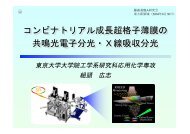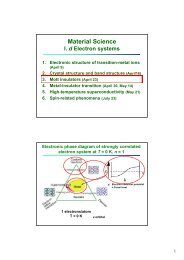Thesis High-Resolution Photoemission Study of Kondo Insulators ...
Thesis High-Resolution Photoemission Study of Kondo Insulators ...
Thesis High-Resolution Photoemission Study of Kondo Insulators ...
Create successful ePaper yourself
Turn your PDF publications into a flip-book with our unique Google optimized e-Paper software.
80 Chapter 6. Substitution and Temperature Dependence <strong>of</strong> the Conduction ...<br />
[6.7].<br />
(iii) The last but the most challenging motivation is to explore new electronic states<br />
near the boundary between the <strong>Kondo</strong> insulator and the <strong>Kondo</strong> metal. Note that hightemperature<br />
superconductivity emerges between the antiferromagnetic insulator and<br />
the normal metal. The electronic states in Yb1−xLuxB12 is worth studying because <strong>of</strong><br />
the unusual temperature-dependent characteristics <strong>of</strong> YbB12.<br />
6.2 Experimental<br />
The Yb1−xLuxB12 single crystals have been grown by floating zone method using an<br />
image furnace with four xenon lamps [6.3]. The phases <strong>of</strong> the prepared samples and<br />
included impurities have been checked by electron probe microanalysis (EPMA) and<br />
analysis <strong>of</strong> magnetic susceptibility. Residual Curie component in the magnetic susceptibility<br />
at low temperature is much reduced compared with that for polycrystals,<br />
especially in the x = 0.50 and 0.75 samples.<br />
The PES measurements were performed for Yb1−xLuxB12 single crystals using a<br />
Scienta SES-200 analyzer and a Gammadata He discharge lamp at Hiroshima University.<br />
The experimental condition for the PES measurements was almost the same as<br />
that for the YbB12 single crystal (Chap. 5). The base pressure in the spectrometer<br />
was ∼ 1.9 × 10−10 Torr. We followed the measurement procedure <strong>of</strong> the YbB12 single<br />
crystal: After scraping the samples at 300 K, we took spectra in the sequence <strong>of</strong> 300<br />
K, 225 K, 150 K, 75 K, and 7 K1 without rescraping it. In the following, we present<br />
data accumulated over five or six series <strong>of</strong> such temperature-sequent measurements.<br />
We evaporated Au on each sample to determine the Fermi level (EF ) and the energy<br />
resolution. The resolution was 10, 14, 14, and 8 meV for x = 0.25, 0.50, 0.75, and<br />
1.00 samples. The background due to signals excited by the satellite lines has been<br />
subtracted systematically in the way described in Chap. 2.<br />
1 Takeda et al. recalibrated the thermometer after the measurement <strong>of</strong> YbB12 (Chap. 5), and<br />
confirmed that the room temperature was ∼ 300 K and the reachable lowest temperature was ∼ 7K.






